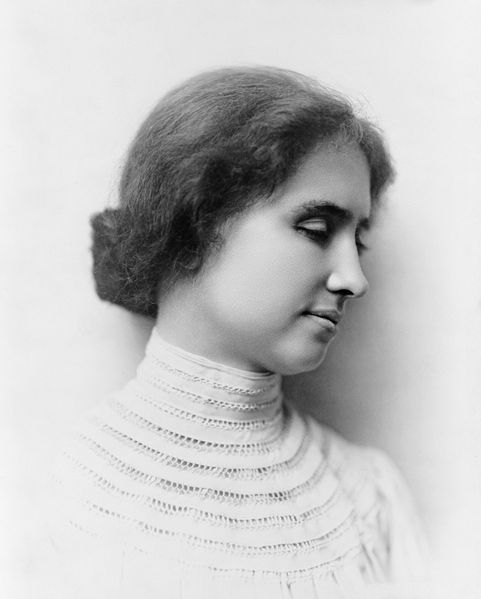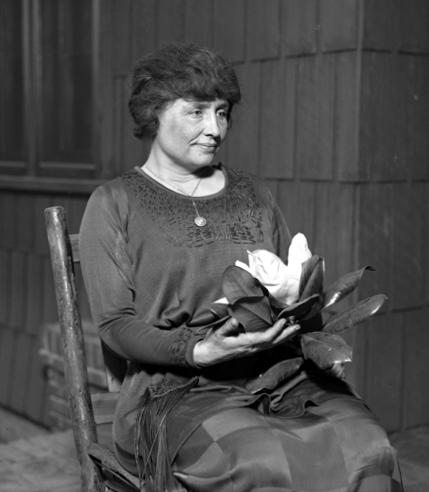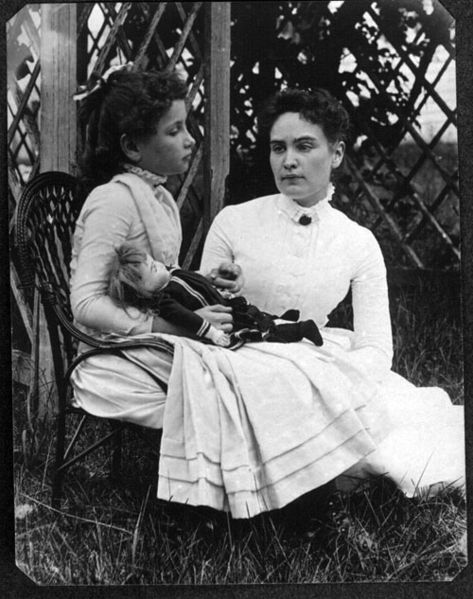<Back to Index>
- Anarchist Philosopher and Activist Emma Goldman, 1869
- Writer and Political Activist Helen Adams Keller, 1880
- Founder of the Irish Parliamentary Party Charles Stewart Parnell, 1846
PAGE SPONSOR



Helen Adams Keller (June 27, 1880 – June 1, 1968) was an American author, political activist, and lecturer. She was the first deafblind person to earn a Bachelor of Arts degree. The story of how Keller's teacher, Anne Sullivan, broke through the isolation imposed by a near complete lack of language, allowing the girl to blossom as she learned to communicate, has become widely known through the dramatic depictions of the play and film The Miracle Worker.
A prolific author, Keller was well traveled, and was outspoken in her opposition to war. A member of the Socialist Party of America and the Wobblies, she campaigned for women's suffrage, workers' rights, and socialism, as well as many other leftist causes.
Helen Adams Keller was born on June 27, 1880, in Tuscumbia, Alabama. Her family lived on a homestead, Ivy Green, that Helen's grandfather had built decades earlier. Helen's father, Arthur H. Keller, spent many years as an editor for the Tuscumbia North Alabamian and had served as a captain for the Confederate Army. Helen's paternal grandmother was the second cousin of Robert E. Lee. Helen's mother, Kate Adams, was the daughter of Charles Adams. Though originally from Massachusetts, Charles Adams also fought for the Confederate Army during the American Civil War, earning the rank of brigadier - general.
Helen's father's lineage can be traced to Casper Keller, a native of Switzerland. Coincidentally, one of Helen's Swiss ancestors was the first teacher for the deaf in Zurich. Helen reflects upon this coincidence in her first autobiography, stating "that there is no king who has not had a slave among his ancestors, and no slave who has not had a king among his."
Helen Keller was not born blind and deaf; it was not until she was 19 months old that she contracted an illness described by doctors as "an acute congestion of the stomach and the brain", which might have been scarlet fever or meningitis. The illness did not last for a particularly long time, but it left her deaf and blind. At that time, she was able to communicate somewhat with Martha Washington, the six year old daughter of the family cook, who understood her signs; by the age of seven, she had over 60 home signs to communicate with her family.
In 1886, her mother, inspired by an account in Charles Dickens' American Notes of the successful education of another deaf and blind woman, Laura Bridgman, dispatched young Helen, accompanied by her father, to seek out Dr. J. Julian Chisolm, an eye, ear, nose, and throat specialist in Baltimore, for advice. He subsequently put them in touch with Alexander Graham Bell, who was working with deaf children at the time. Bell advised the couple to contact the Perkins Institute for the Blind, the school where Bridgman had been educated, which was then located in South Boston. Michael Anaganos, the school's director, asked former student Anne Sullivan, herself visually impaired and only 20 years old, to become Keller's instructor. It was the beginning of a 49 year long relationship, Sullivan evolving into governess and then eventual companion.
Anne Sullivan arrived at Keller's house in March 1887, and immediately began to teach Helen to communicate by spelling words into her hand, beginning with "d-o-l-l" for the doll that she had brought Keller as a present. Keller was frustrated, at first, because she did not understand that every object had a word uniquely identifying it. In fact, when Sullivan was trying to teach Keller the word for "mug", Keller became so frustrated she broke the doll. Keller's big breakthrough in communication came the next month, when she realized that the motions her teacher was making on the palm of her hand, while running cool water over her other hand, symbolized the idea of "water"; she then nearly exhausted Sullivan demanding the names of all the other familiar objects in her world.
Due to a protruding left eye, Keller was usually photographed in profile. Both her eyes were replaced in adulthood with glass replicas for "medical and cosmetic reasons".
Starting in May, 1888, Keller attended the
Perkins Institute for the Blind. In 1894, Helen Keller and Anne Sullivan moved to New York to attend the Wright - Humason School for the Deaf, and to learn from Sarah Fuller at the Horace Mann School for the Deaf. In 1896, they returned to Massachusetts and Keller entered The Cambridge School for Young Ladies before gaining admittance, in 1900, to Radcliffe College, where she lived in Briggs Hall, South House. Her admirer, Mark Twain, had introduced her to Standard Oil magnate Henry Huttleston Rogers,
who, with his wife Abbie, paid for her education. In 1904, at the age
of 24, Keller graduated from Radcliffe, becoming the first deaf blind
person to earn a Bachelor of Arts degree. She maintained a
correspondence with the Austrian philosopher and pedagogue Wilhelm Jerusalem, who was one of the first to discover her literary talent.
Keller moved to Forest Hills, Queens, together with Anne and John, and used the house as a base for her efforts on behalf of American Foundation for the Blind.
After Anne died in 1936, Keller and Thompson moved to Connecticut. They traveled worldwide and raised funding for the blind. Thompson had a stroke in 1957 from which she never fully recovered, and died in 1960.
Winnie Corbally, a nurse who was originally brought in to care for Thompson in 1957, stayed on after her death and was Keller's companion for the rest of her life.
Keller went on to become a world famous speaker and author. She is remembered as an advocate for people with disabilities, amid numerous other causes. She was a suffragist, a pacifist, an opponent of Woodrow Wilson, a radical socialist and a birth control supporter. In 1915 she and George Kessler founded the Helen Keller International (HKI) organization. This organization is devoted to research in vision, health and nutrition. In 1920 she helped to found the American Civil Liberties Union (ACLU). Keller traveled to over 39 countries with Sullivan, making several trips to Japan and becoming a favorite of the Japanese people. Keller met every U.S. President from Grover Cleveland to Lyndon B. Johnson and was friends with many famous figures, including Alexander Graham Bell, Charlie Chaplin and Mark Twain. Keller and Mark Twain were both considered radicals at the beginning of the 20th century, and as a consequence, their political views have been forgotten or glossed over in popular perception.
Keller was a member of the Socialist Party and actively campaigned and wrote in support of the working class from 1909 to 1921. She supported Socialist Party candidate Eugene V. Debs in each of his campaigns for the presidency. Newspaper columnists who had praised her courage and intelligence before she expressed her socialist views now called attention to her disabilities. The editor of the Brooklyn Eagle wrote that her "mistakes sprung out of the manifest limitations of her development." Keller responded to that editor, referring to having met him before he knew of her political views:
Keller joined the Industrial Workers of the World (known as the IWW or the Wobblies) in 1912, saying that parliamentary socialism was "sinking in the political bog". She wrote for the IWW between 1916 and 1918. In Why I Became an IWW, Keller explained that her motivation for activism came in part from her concern about blindness and other disabilities:
| “ | I was appointed on a commission to investigate the conditions of the blind. For the first time I, who had thought blindness a misfortune beyond human control, found that too much of it was traceable to wrong industrial conditions, often caused by the selfishness and greed of employers. And the social evil contributed its share. I found that poverty drove women to a life of shame that ended in blindness. | ” |
The last sentence refers to prostitution and syphilis, the former a frequent cause of the latter, and the latter a leading cause of blindness.
Keller wrote a total of 12 published books and several articles.
One of her earliest pieces of writing, at age 11, was The Frost King (1891). There were allegations that this story had been plagiarized from The Frost Fairies by Margaret Canby. An investigation into the matter revealed that Keller may have experienced a case of cryptomnesia, which was that she had Canby's story read to her but forgot about it, while the memory remained in her subconscious.
At age 22, Keller published her autobiography, The Story of My Life (1903), with help from Sullivan and Sullivan's husband, John Macy. It includes words that Keller wrote and the story of her life up to age 21, and was written during her time in college.
Keller wrote The World I Live In in 1908 giving readers an insight into how she felt about the world. Out of the Dark, a series of essays on socialism, was published in 1913.
When Keller was young, Anne Sullivan introduced her to Phillips Brooks, who introduced her to Christianity, Keller famously saying: "I always knew He was there, but I didn't know His name!
Her spiritual autobiography, My Religion, was published in 1927 and then in 1994 extensively revised and re-issued under the title Light in My Darkness. It advocates the teachings of Emanuel Swedenborg, the Christian revelator and theologian who gives a spiritual interpretation of the teachings of the Bible and who claims that the second coming of Jesus Christ has already taken place. Adherents use several names to describe themselves, including Second Advent Christian, Swedenborgian and New Church.
When Keller visited Akita Prefecture in Japan in July 1937, she inquired about Hachikō, the famed Akita dog that had died in 1935. She told a Japanese person that she would like to have an Akita dog; one was given to her within a month, with the name of Kamikaze-go. When he died of canine distemper, his older brother, Kenzan-go, was presented to her as an official gift from the Japanese government in July 1938. Keller is credited with having introduced the Akita to the United States through these two dogs.
By 1939 a breed standard had been established and dog shows had been held, but such activities stopped after World War II began. Keller wrote in the Akita Journal:
eller suffered a series of strokes in 1961 and spent the last years of her life at her home.
On September 14, 1964, President Lyndon B. Johnson awarded her the Presidential Medal of Freedom, one of the United States' highest two civilian honors. In 1965 she was elected to the National Women's Hall of Fame at the New York World's Fair.
Keller devoted much of her later life to raising funds for the American Foundation for the Blind. She died in her sleep on June 1, 1968, at her home, Arcan Ridge, located in Easton, Connecticut. A service was held in her honor at the National Cathedral in Washington, D.C., and her ashes were placed there next to her constant companions, Anne Sullivan and Polly Thompson.
Keller's life has been interpreted many times. She appeared in a silent film, Deliverance (1919), which told her story in a melodramatic, allegorical style. She was also the subject of the documentaries Helen Keller in Her Story, narrated by Katharine Cornell, and The Story of Helen Keller, part of the Famous Americans series produced by Hearst Entertainment.
The Miracle Worker is a cycle of dramatic works ultimately derived from her autobiography, The Story of My Life. The various dramas each describe the relationship between Keller and Sullivan, depicting how the teacher led her from a state of almost feral wildness into education, activism, and intellectual celebrity. The common title of the cycle echoes Mark Twain's description of Sullivan as a "miracle worker." Its first realization was the 1957 Playhouse 90 teleplay of that title by William Gibson. He adapted it for a Broadway production in 1959 and an Oscar winning feature film in 1962, starring Anne Bancroft and Patty Duke. It was remade for television in 1979 and 2000.
In 1984, Helen Keller's life story was made into a TV movie called The Miracle Continues. This film that entailed the semi - sequel to The Miracle Worker recounts her college years and her early adult life. None of the early movies hint at the social activism that would become the hallmark of Keller's later life, although Disney version produced in 2000 states in the credits that she became an activist for social equality.
The Bollywood movie Black (2005) was largely based on Keller's story, from her childhood to her graduation. A documentary called Shining Soul: Helen Keller's Spiritual Life and Legacy was produced by the Swedenborg Foundation in the same year. The film focuses on the role played by Emanuel Swedenborg's spiritual theology in her life and how it inspired Keller's triumph over her triple disabilities of blindness, deafness and a severe speech impediment.
On March 6, 2008, the New England Historic Genealogical Society announced that a staff member had discovered a rare 1888 photograph showing Helen and Anne, which, although previously published, had escaped widespread attention. Depicting Helen holding one of her many dolls, it is believed to be the earliest surviving photograph of Anne.
In 1999, Keller was listed in Gallup's Most Widely Admired People of the 20th Century. In 2003, Alabama honored its native daughter on its state quarter. The Helen Keller Hospital in Sheffield, Alabama is dedicated to her. There are streets named after Helen Keller in Getafe, Spain, in Lod, Israel and in Lisbon, Portugal. A preschool for the deaf and hard of hearing in Mysore, India, was originally named after Helen Keller by its founder K.K. Srinivasan.
On October 7, 2009, a bronze statue of Helen Keller was added to the National Statuary Hall Collection, as a replacement for the State of Alabama's former 1908 statue of the education reformer Jabez Lamar Monroe Curry. It is displayed in the United States Capitol Visitor Center and depicts Keller as a seven year old child standing at a water pump. The statue represents the seminal moment in Keller's life when she understood her first word: W-A-T-E-R, as signed into her hand by teacher Anne Sullivan. The pedestal base bears a quotation in raised letters and Braille characters: "The best and most beautiful things in the world cannot be seen or even touched, they must be felt with the heart." The statue is the first one of a handicapped person and of a child to be permanently displayed at the U.S. Capitol.